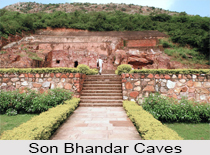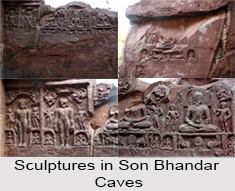 Son Bhandar Caves is located at the foot of the Vaibhava Hill in the ancient capital of North India, Rajgir. These caves are most important pillar to show the Buddhist art forms of ancient India, as Rajgir was the seat of many ancient empires of India. These caves are divided into the Western caves and Eastern cave and date back to the century. Both caves of Son Bhandar seem to be hollowed in the cliff in 3rd to 4th century AD. There are the Buddhist inscriptions inside the western cave of Son Bhandar Caves, between the door and window tells that it was done by the Great Saint of Jains, Muni Vairadevi for Jain ascetics in this time. Both caves were made approximately at the same time, during the rule of Bimbisara, the glorious founder of Magadha Empire.
Son Bhandar Caves is located at the foot of the Vaibhava Hill in the ancient capital of North India, Rajgir. These caves are most important pillar to show the Buddhist art forms of ancient India, as Rajgir was the seat of many ancient empires of India. These caves are divided into the Western caves and Eastern cave and date back to the century. Both caves of Son Bhandar seem to be hollowed in the cliff in 3rd to 4th century AD. There are the Buddhist inscriptions inside the western cave of Son Bhandar Caves, between the door and window tells that it was done by the Great Saint of Jains, Muni Vairadevi for Jain ascetics in this time. Both caves were made approximately at the same time, during the rule of Bimbisara, the glorious founder of Magadha Empire.
There are many more brief Buddhist inscriptions inside and outside the caves of Son Bhandar from late 5th to early 6th Century, most likely left by different pilgrims of North India. The western part of Son Bhandar Caves gave the name to this Buddhist Cave, Son Bhandar which means the “store of goldâ€. The legend shows that the treasure of Son Bhandar Caves is linked to western cave of Son Bhandar Caves.
Legends of Son Bhandar Caves
The myths of Son Bhandar Caves tell that, this cave still hides a passage to the treasury of gold. The entrance in this passage is well hidden in the cave chamber behind an ancient stone wedge. Some also believe that the passage goes through Vaibhargiri Mountain and reaches Saptaparni Caves on the other side of range.
 Some believe that this mythical gold treasure belonged to Jarasandha, the mythical king of Hinduism, which was that to Bimbisara. When Ajatashatru confined his father Bimbisara his mother secretly hid some wealth and later donated it to Jain Tirthankaras.
Some believe that this mythical gold treasure belonged to Jarasandha, the mythical king of Hinduism, which was that to Bimbisara. When Ajatashatru confined his father Bimbisara his mother secretly hid some wealth and later donated it to Jain Tirthankaras.
Structure of Son Bhandar Caves
Son Bhandar Caves is believed to be a guard cave. It contains a single rectangular chamber, 10.4 X 5.2 metres large. The vaulted ceiling of Son Bhandar Caves stands on vertical walls, vault rises up to 1.5 meters high. This resembles the style of older Mauryan rock-cut sanctuaries. In ancient times most likely there was a roofed veranda in the front of caves.
The walls, doorjambs and front wall of Son Bhandar Caves contains numerous epigraphs. The small image of standing Lord Vishnu is etched on the left side of doorway. In the wall of Son Bhandar Caves, there is seen a trace of carving, resembling a doorway and next to it, an un-deciphered inscription. There is also a black mark above or in the upper part of Son Bhandar Caves which marks the mysterious doorway, is of left by cannonball when British tried to break the wall and enter the passage of Son Bhandar Caves.
The eastern part of the Son Bhandar Caves is partly ruined. The front part of the caves chamber has fallen. The upper floor of the caves above the cliff made in brick is added later, during Gupta period and possibly caused the collapse of front wall of the Son Bhandar Caves. The veranda in front of the southern wall of Son Bhandar Caves contains important early Jain artwork, which are exquisitely sculpted small relics of 6 Jain Tirthankaras.



















